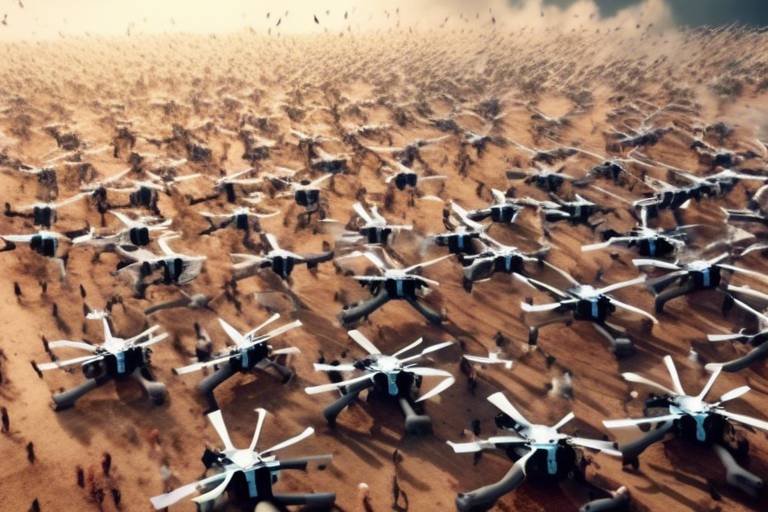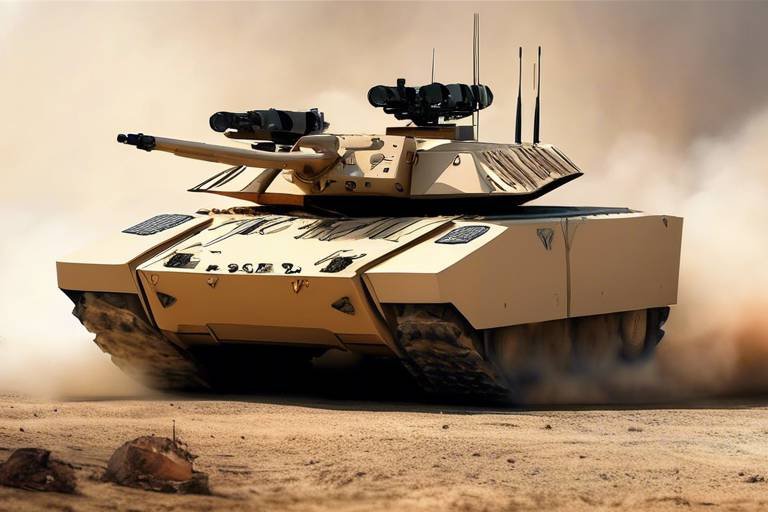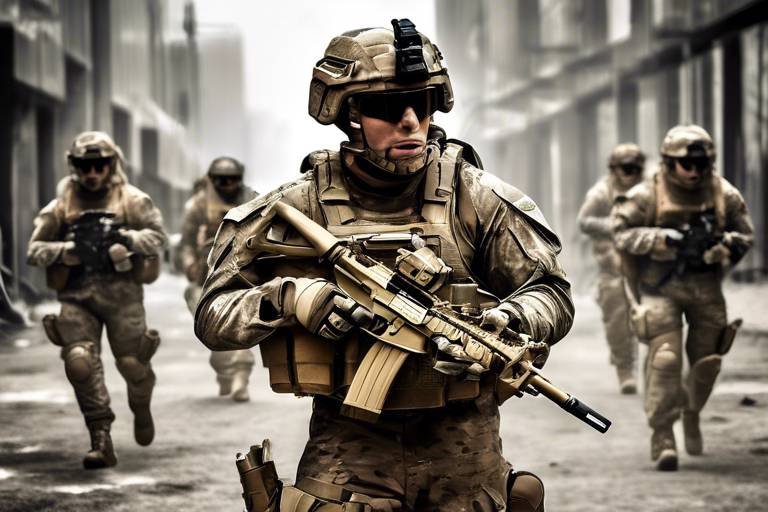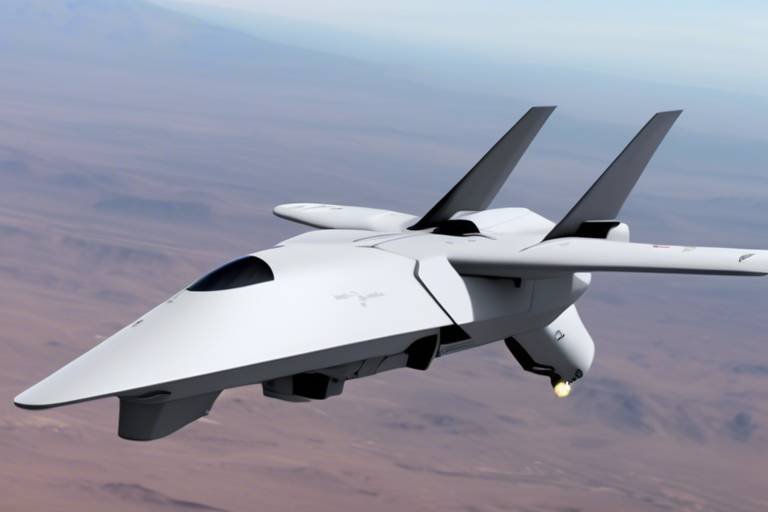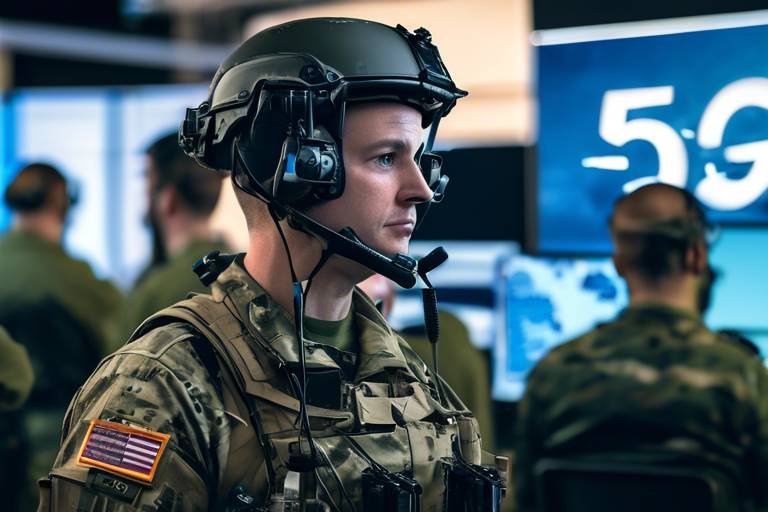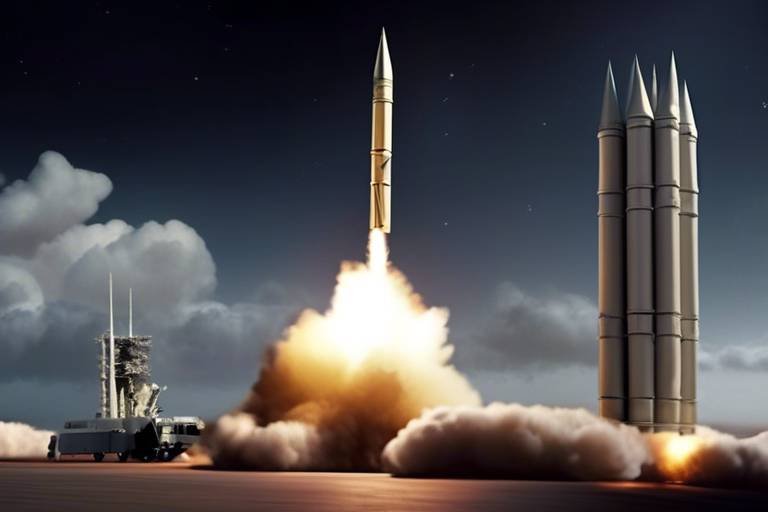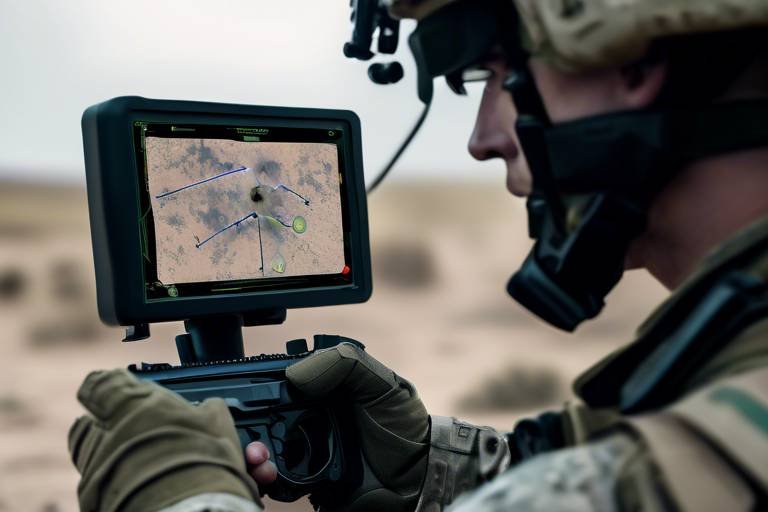AI-Powered Naval Drones - Changing the Face of Sea Combat
In the vast and unpredictable realms of the ocean, where the stakes are high and the tides can turn in an instant, AI-powered naval drones are emerging as game-changers. Just imagine a world where unmanned vehicles, equipped with cutting-edge artificial intelligence, can traverse the seas, gather intelligence, and even engage in combat—all without putting human lives at risk. This isn’t just science fiction; it’s the new reality of modern warfare. The integration of AI technologies into naval drones is not merely a trend; it’s a revolution that is reshaping how nations approach maritime security and combat operations.
The evolution of naval warfare has always been marked by technological advancements. From the introduction of steam-powered ships to the advent of nuclear submarines, each innovation has significantly altered the landscape of sea combat. Today, we stand at the precipice of another monumental shift, one driven by artificial intelligence. As we delve deeper into this topic, we’ll explore how these drones operate, the technology behind them, and the profound implications they hold for future naval engagements.
AI-powered naval drones are designed to enhance operational efficiency and effectiveness on the battlefield. They are equipped with sophisticated machine learning algorithms that allow them to process vast amounts of data in real time. This capability not only improves decision-making processes but also enables these drones to adapt to dynamic combat situations. For instance, during a naval engagement, a drone can analyze enemy movements and predict their next steps, providing commanders with a significant tactical advantage.
Moreover, the autonomous navigation systems integrated into these drones allow them to operate independently, reducing the reliance on human operators. This is crucial in high-risk scenarios where human lives could be endangered. With the ability to navigate complex environments autonomously, these drones can execute missions with a higher success rate, all while minimizing the potential for human error.
In addition to their operational capabilities, AI-powered naval drones bring forth strategic advantages that are hard to overlook. For one, they significantly reduce operational costs. Deploying unmanned vessels means fewer manned ships are needed, which translates to lower personnel costs and decreased risks associated with human lives in perilous missions. Imagine a fleet of drones patrolling the waters, gathering intelligence, and engaging threats—all while keeping our sailors safe.
Enhanced situational awareness is another benefit that these drones offer. With real-time data integration, commanders can make informed decisions quickly, adapting to evolving scenarios on the fly. This capability is paramount in naval operations, where every second counts, and the margin for error is razor-thin.
However, with great power comes great responsibility. The rise of AI-powered naval drones does not come without its challenges and ethical considerations. As these machines operate autonomously, questions about accountability arise. Who is responsible for the actions taken by a drone during a mission? This dilemma necessitates a robust discussion on ethical frameworks and legal implications surrounding the deployment of such technologies.
Furthermore, there is a potential for misuse of AI technology in warfare. The very capabilities that make these drones advantageous could also be exploited by rogue states or non-state actors. Establishing regulations and guidelines to govern the deployment of AI in naval warfare is crucial to mitigate these risks and ensure that these powerful tools are used responsibly.
- What are AI-powered naval drones?
AI-powered naval drones are unmanned vehicles equipped with artificial intelligence technologies that enable them to perform various tasks in naval warfare, including surveillance, reconnaissance, and combat operations. - How do AI technologies enhance naval drones?
AI technologies, such as machine learning and computer vision, enhance naval drones by improving their decision-making processes, enabling autonomous navigation, and increasing their target identification capabilities. - What are the strategic advantages of using AI-powered naval drones?
These drones offer strategic advantages such as reduced operational costs, enhanced situational awareness, and improved mission outcomes, which can reshape naval tactics and strategies. - What ethical considerations are associated with AI naval drones?
The use of AI naval drones raises ethical questions regarding accountability for autonomous actions and the potential for misuse of technology in warfare.

The Evolution of Naval Warfare
The journey of naval warfare is as vast and intricate as the oceans themselves. From the **ancient galleys** powered by oars and sails to today's **high-tech vessels** equipped with cutting-edge technology, the evolution of naval combat tells a story of human ingenuity and adaptation. Imagine the early sailors, navigating treacherous waters with little more than a compass and their instincts. Fast forward to today, and we see a dramatic shift where **AI-powered naval drones** are taking center stage, reshaping the landscape of maritime conflict.
Historically, naval battles were fought with ships that relied heavily on human skill and brute force. The introduction of **gunpowder** marked a significant turning point, allowing navies to utilize cannons and other artillery, which changed the dynamics of sea engagements. As technology advanced, so did the complexity of naval tactics. The **Industrial Revolution** brought about steam-powered ships, enabling faster and more efficient naval operations. This period also saw the rise of **submarines** and **aircraft carriers**, which further transformed naval strategies.
In the 20th century, the world witnessed two devastating World Wars, where naval warfare played a crucial role. The **Battle of Midway**, for instance, showcased how intelligence and strategy could turn the tide of war. The introduction of radar technology allowed for better detection of enemy vessels, while aircraft carriers became the backbone of naval fleets. The Cold War era brought about an arms race, leading to the development of **nuclear submarines** and advanced missile systems, which added layers of complexity to naval warfare.
Today, we stand on the brink of a new era, one characterized by the integration of **artificial intelligence** and **autonomous systems**. The rise of **AI-powered naval drones** signifies a shift from traditional manned vessels to unmanned operations, where drones can perform reconnaissance, surveillance, and even combat missions with minimal human intervention. This transformation is not just about technology; it's about redefining strategies and tactics in naval warfare.
To further illustrate this evolution, consider the following table that highlights key milestones in naval warfare:
| Era | Key Developments | Impact on Naval Warfare |
|---|---|---|
| Ancient Times | Galleys, Sails | Basic naval combat, reliance on manpower |
| Gunpowder Era | Cannons, Artillery | Shift to firepower and tactics |
| Industrial Revolution | Steam-Powered Ships, Submarines | Increased speed and operational range |
| World Wars | Aircraft Carriers, Radar | Strategic dominance at sea |
| Modern Era | AI-Powered Drones | Autonomous operations, redefined tactics |
As we look to the future, the integration of AI in naval warfare promises to enhance operational efficiency and effectiveness. The ability to analyze vast amounts of data, predict enemy movements, and operate autonomously will undoubtedly change the way naval battles are fought. The evolution of naval warfare is not just a timeline of technological advancements; it's a testament to humanity's relentless pursuit of innovation and strategic superiority on the high seas.
- What are AI-powered naval drones? AI-powered naval drones are unmanned aerial vehicles equipped with artificial intelligence that can perform various missions, including reconnaissance, surveillance, and combat operations.
- How do AI technologies enhance naval warfare? AI technologies improve decision-making, situational awareness, and operational efficiency by analyzing data in real-time and predicting enemy actions.
- What are the ethical concerns surrounding the use of AI in naval warfare? Ethical concerns include accountability for autonomous operations, the potential for misuse of technology, and the implications for human lives in combat scenarios.

AI Technology in Naval Drones
The integration of AI technology into naval drones marks a significant turning point in modern warfare. These advanced machines are not just tools; they are intelligent entities capable of making decisions and adapting to dynamic combat scenarios. Imagine having a fleet of drones that can think, learn, and act with a level of precision that surpasses human capabilities. This is not science fiction; it's the reality of today's naval combat. By utilizing cutting-edge technologies such as machine learning, computer vision, and autonomous navigation systems, naval drones are redefining how battles are fought at sea.
At the heart of these innovations lies machine learning, which allows drones to process and analyze vast amounts of data in real-time. Picture a drone scanning the ocean for enemy vessels; it doesn't just react to what it sees but learns from the data collected over time, improving its decision-making abilities with each mission. This capability is crucial in high-stakes environments where every second counts. The drones can identify patterns, predict enemy movements, and even suggest tactical maneuvers to human operators, enhancing overall operational efficiency.
Machine learning applications in naval drones are diverse and impactful. For instance, these drones can utilize predictive modeling to foresee potential threats and enemy strategies. By analyzing historical data and current battlefield conditions, they can generate actionable insights that give commanders a significant edge. The information these drones provide is not just data; it's a comprehensive analysis that can dictate the outcome of a naval engagement.
The ability to anticipate enemy actions is a game-changer. With predictive modeling, AI-powered drones can create scenarios based on existing data, allowing for preemptive strikes or evasive maneuvers. This capability can be illustrated in a table:
| Data Type | Application | Outcome |
|---|---|---|
| Historical Engagement Data | Predict enemy tactics | Increased success rates in engagements |
| Real-time Sensor Data | Adjust flight paths | Enhanced survival and mission success |
| Environmental Conditions | Optimize operational strategies | Improved efficiency and effectiveness |
Another critical component of AI technology in naval drones is autonomous navigation systems. These systems allow drones to operate with minimal human intervention, navigating complex environments and executing missions efficiently. Think of them as the autopilot of the sea, capable of adjusting to unforeseen circumstances and obstacles. This autonomy not only increases the success rate of missions but also ensures the safety of human operators by reducing their exposure to danger.
Moreover, computer vision technologies empower naval drones to identify and track targets with astonishing accuracy. This capability is crucial during reconnaissance missions, where the ability to detect enemy vessels or threats can mean the difference between victory and defeat. With advanced algorithms, these drones can process visual data, distinguishing between friend and foe in real-time, ensuring that commanders have the most accurate and timely information at their disposal.
In conclusion, the incorporation of AI technologies into naval drones is not just a trend; it's a revolution. These advancements are transforming naval warfare, enhancing decision-making, and providing tactical advantages that were previously unimaginable. As we continue to explore the potential of AI in military applications, one thing is clear: the future of naval combat will be shaped by these intelligent machines.
- What are AI-powered naval drones?
AI-powered naval drones are unmanned aerial vehicles equipped with artificial intelligence technologies that allow them to operate autonomously, analyze data, and make decisions in real-time during naval operations. - How do machine learning algorithms improve naval drones?
Machine learning algorithms enable naval drones to learn from data, enhance their decision-making capabilities, and predict enemy movements, thereby improving operational efficiency. - What role does computer vision play in naval drones?
Computer vision allows naval drones to identify and track targets accurately, enhancing their reconnaissance capabilities and ensuring better situational awareness during missions. - What are the ethical implications of using AI in naval warfare?
The use of AI in naval warfare raises questions about accountability, decision-making, and the potential for misuse, necessitating discussions about ethical frameworks and regulations.

Machine Learning Applications
Machine learning is the beating heart of modern AI-powered naval drones, transforming the way these machines operate in combat scenarios. Imagine a drone that not only flies autonomously but also learns from its environment, adapting to new challenges in real-time. This capability is crucial in naval warfare, where conditions can change rapidly and unpredictably. The application of machine learning enables these drones to process vast amounts of data, making split-second decisions that could mean the difference between victory and defeat.
One of the most impressive aspects of machine learning in naval drones is their ability to analyze data from various sources, such as satellite imagery, sonar readings, and even social media feeds. By employing sophisticated algorithms, these drones can identify patterns and anomalies that human operators might overlook. For instance, if a naval drone detects unusual movements in enemy ships, it can alert commanders and suggest tactical responses based on historical data and predictive modeling.
Moreover, the integration of machine learning allows for predictive modeling, which is a game-changer in anticipating enemy actions. Picture this: a drone equipped with machine learning algorithms can forecast potential threats by analyzing previous engagements and current battlefield conditions. This predictive capability not only enhances situational awareness but also gives naval forces a significant edge in planning their strategies. The ability to foresee enemy movements can lead to proactive measures that disrupt adversaries before they can execute their plans.
Additionally, machine learning enhances the operational efficiency of naval drones. By continuously learning from their missions, these drones can refine their navigation and targeting systems. This means they can operate in complex environments—such as crowded shipping lanes or hostile waters—without requiring constant human oversight. The reduction in human intervention not only minimizes the risk to personnel but also increases the drones' mission success rates.
To illustrate the impact of machine learning on naval drone operations, consider the following table that highlights key applications:
| Application | Description |
|---|---|
| Data Analysis | Real-time processing of sensor data to identify threats and opportunities. |
| Predictive Modeling | Forecasting enemy movements and strategizing accordingly. |
| Autonomous Decision-Making | Executing missions with minimal human input, enhancing efficiency. |
| Adaptive Learning | Learning from past missions to improve future performance. |
In summary, machine learning applications in naval drones are not just about automation; they represent a fundamental shift in how naval warfare is conducted. By leveraging the power of AI, these drones can analyze data, predict enemy actions, and operate autonomously, providing naval forces with unprecedented capabilities. As we continue to explore the potential of AI in military operations, it’s clear that machine learning will play a pivotal role in shaping the future of naval combat.
- What are the main benefits of using machine learning in naval drones?
Machine learning enhances data analysis, predictive modeling, and autonomous decision-making, which improves operational efficiency and situational awareness.
- How do AI-powered naval drones learn from their environment?
These drones utilize algorithms that analyze data from various sources, allowing them to adapt and respond to changing conditions in real-time.
- What challenges are associated with machine learning in military applications?
Challenges include ensuring accountability for autonomous actions, addressing potential biases in algorithms, and managing the ethical implications of AI in warfare.

Data Analysis and Predictive Modeling
When it comes to modern naval warfare, the ability to predict enemy movements and strategize effectively is akin to having a crystal ball. This is where data analysis and predictive modeling come into play, revolutionizing the way naval drones operate. Imagine a scenario where a naval drone can analyze vast amounts of data in real-time, allowing it to foresee potential threats and opportunities before they even arise. This capability is not just a luxury; it’s a necessity in the fast-paced world of maritime combat.
Data analysis involves processing and interpreting large datasets, which can include everything from weather patterns to enemy ship movements. By utilizing advanced algorithms, AI-powered naval drones can sift through this information to identify trends and patterns that human operators may overlook. For instance, if a drone detects a sudden increase in radar activity from a specific location, it can alert commanders to a potential ambush or an enemy fleet's approach.
Predictive modeling takes this a step further. By employing historical data, AI systems can create models that forecast future scenarios based on current conditions. This is particularly useful in naval warfare, where the ocean's unpredictability can turn the tide of battle in an instant. For example, if a drone has access to previous naval engagements, it can analyze the tactics used by adversaries and predict their next moves, giving commanders a tactical edge.
To illustrate the significance of data analysis and predictive modeling in naval operations, consider the following table:
| Aspect | Traditional Methods | AI-Powered Drones |
|---|---|---|
| Data Processing Speed | Slow, manual analysis | Real-time, automated analysis |
| Accuracy of Predictions | Limited by human intuition | High, based on data-driven models |
| Response Time | Delayed decision-making | Immediate tactical adjustments |
| Operational Efficiency | Resource-intensive | Cost-effective and streamlined |
This table highlights the transformative impact of AI technologies on naval operations. The ability to process data swiftly and accurately not only enhances situational awareness but also allows for proactive measures against potential threats. In the heat of battle, where every second counts, having a drone that can predict enemy actions with precision is invaluable.
Moreover, the integration of predictive modeling into naval strategies fosters a culture of anticipation rather than reaction. Commanders can plan their maneuvers based on solid data rather than guesswork, leading to more successful outcomes in engagements. This shift in mindset is crucial as naval warfare evolves into a more technologically driven arena.
In summary, the combination of data analysis and predictive modeling equips AI-powered naval drones with the tools necessary to redefine naval combat. As these technologies continue to advance, the potential for enhanced operational capabilities will only grow, making the seas a more complex battleground where knowledge is power.
- What are AI-powered naval drones?
AI-powered naval drones are unmanned vehicles that utilize artificial intelligence to enhance their operational capabilities, including navigation, data analysis, and target identification. - How does predictive modeling work in naval warfare?
Predictive modeling uses historical data to forecast future scenarios, helping commanders anticipate enemy movements and strategize effectively. - What are the advantages of using AI in naval combat?
AI enhances situational awareness, reduces operational costs, and improves decision-making speed, leading to more effective military strategies. - Are there ethical concerns regarding the use of AI in warfare?
Yes, there are significant ethical considerations, including accountability for autonomous actions and the potential for misuse of AI technologies.

Autonomous Navigation Systems
The advent of in naval drones marks a significant leap forward in maritime technology. Imagine a vessel that can navigate treacherous waters, avoid obstacles, and execute complex maneuvers without human intervention. This is not science fiction; it's the reality brought about by cutting-edge AI technology. These systems utilize a combination of advanced sensors, real-time data processing, and machine learning algorithms to operate independently, allowing them to adapt to changing environments and mission requirements.
One of the most remarkable features of autonomous navigation is its ability to reduce human error. In high-stakes situations, the margin for error is minimal. By employing AI, naval drones can make split-second decisions based on their surroundings, enhancing mission success rates. For instance, if a drone encounters an unexpected obstacle, it can quickly analyze the situation and choose the safest course of action without waiting for instructions from a human operator. This capability not only increases efficiency but also significantly enhances operational safety, particularly in hostile environments.
Moreover, autonomous navigation systems are equipped with machine learning capabilities that allow them to learn from past experiences. Over time, these drones can refine their navigation strategies, improving their performance in various scenarios. For example, if a drone successfully navigates a particular route under challenging conditions, it can store that information and apply it to future missions, essentially becoming smarter with each deployment.
To better understand how autonomous navigation systems function, consider the following key components:
- Sensors: These include GPS, radar, and sonar, which provide real-time data about the drone's environment.
- Data Processing: Advanced algorithms analyze incoming data to make navigation decisions.
- Feedback Mechanisms: Drones continuously monitor their performance and adjust their strategies accordingly.
In summary, autonomous navigation systems are revolutionizing naval operations by enabling drones to act with a level of independence and precision previously thought impossible. As these technologies continue to evolve, we can expect even greater advancements that will further enhance the capabilities of naval drones, transforming the future of maritime warfare.
- What are autonomous navigation systems?
Autonomous navigation systems are advanced technologies that allow drones to navigate and operate independently without human intervention, utilizing sensors and AI algorithms. - How do these systems improve operational safety?
By reducing human error and enabling real-time decision-making, autonomous navigation systems enhance safety during missions, particularly in hazardous environments. - Can autonomous drones learn from past experiences?
Yes, many autonomous drones use machine learning to analyze previous missions and improve their navigation strategies over time.

Computer Vision Capabilities
The integration of computer vision technologies into naval drones represents a groundbreaking advancement in modern warfare. Imagine a drone soaring over the vast ocean, equipped with the ability to see and understand its surroundings in real-time, much like a hawk scanning its territory from the sky. This capability not only enhances the operational effectiveness of these drones but also transforms how naval forces conduct reconnaissance and surveillance missions.
At the heart of this technology lies the ability to process visual data rapidly and accurately. By utilizing sophisticated algorithms, AI-powered naval drones can identify and track multiple targets simultaneously, even under challenging conditions such as poor visibility or inclement weather. This is akin to having a highly trained crew member onboard who can analyze the battlefield and relay critical information back to command in the blink of an eye.
One of the most significant advantages of computer vision in naval drones is its ability to provide real-time data interpretation. For instance, during a surveillance mission, a drone can capture high-resolution images and video feeds, which are then analyzed using machine learning techniques to detect potential threats. This capability transforms raw data into actionable intelligence, allowing commanders to make informed decisions swiftly and effectively.
Furthermore, the precision of computer vision enhances target recognition, which is crucial during military operations. For example, a naval drone equipped with advanced imaging systems can differentiate between enemy vessels and harmless civilian ships, reducing the risk of friendly fire incidents. This level of accuracy is essential in maintaining operational integrity and upholding international laws of engagement.
To illustrate the impact of computer vision on naval operations, consider the following table that outlines key capabilities and their implications:
| Capability | Description | Implication |
|---|---|---|
| Real-time Target Tracking | Ability to monitor multiple targets simultaneously. | Enhances situational awareness and operational responsiveness. |
| High-Resolution Imaging | Captures detailed images for analysis. | Improves accuracy in threat identification. |
| Automated Threat Detection | Utilizes AI to identify potential threats autonomously. | Reduces human error and speeds up decision-making. |
In addition, the ability of naval drones to integrate with other systems and platforms further enhances their effectiveness. For instance, data gathered by drones can be shared with naval fleets, providing a comprehensive view of the operational environment. This interconnectedness allows for coordinated responses to emerging threats, making naval operations more efficient and effective.
However, as we embrace these technological advancements, it is crucial to consider the implications of relying on AI and computer vision in military operations. Questions surrounding ethical considerations, accountability, and the potential for misuse must be addressed to ensure that these powerful tools are used responsibly. As we navigate the future of naval warfare, the balance between technological prowess and ethical responsibility will be paramount.
- What is computer vision in naval drones? Computer vision refers to the technology that enables these drones to interpret visual data, identify objects, and track targets in real-time.
- How does computer vision enhance naval operations? It improves target recognition, situational awareness, and the speed of decision-making during missions.
- Are there any risks associated with using AI in naval warfare? Yes, there are ethical concerns regarding accountability and the potential for misuse of AI technologies.

Strategic Advantages of AI Drones
AI-powered naval drones are not just a technological marvel; they represent a significant shift in how naval warfare is conducted. These drones bring a plethora of strategic advantages that can reshape the very fabric of military operations at sea. One of the most compelling benefits is their ability to enhance situational awareness. Imagine a scenario where a naval commander can access real-time data from multiple sources, all synthesized and analyzed by AI. This level of insight allows for quicker, more informed decision-making, which is crucial in the fast-paced environment of naval combat.
Moreover, the cost-effectiveness of deploying AI drones cannot be overstated. Traditional naval operations often involve manned vessels, which are not only costly to maintain but also put human lives at risk. By utilizing unmanned drones, navies can significantly reduce operational expenses while minimizing the dangers associated with human crews. This shift not only saves money but also allows for a reallocation of resources to other critical areas, such as training and technology development.
Another advantage lies in the improved mission outcomes that AI drones facilitate. With their advanced sensors and AI-driven analytics, these drones can perform complex missions that would be challenging for human operators. For instance, they can execute reconnaissance missions in hostile environments without the fear of losing valuable personnel. This capability not only increases the likelihood of mission success but also enables navies to gather critical intelligence that can inform future operations.
To illustrate the strategic advantages more clearly, consider the following table that compares traditional naval operations with AI-powered drone operations:
| Aspect | Traditional Naval Operations | AI-Powered Drone Operations |
|---|---|---|
| Cost | High due to manned vessels | Lower, fewer personnel required |
| Risk to Personnel | High | Minimal |
| Operational Flexibility | Limited by crew capabilities | Highly flexible, can adapt quickly |
| Data Analysis Speed | Slower, reliant on human processing | Rapid, AI-driven analytics |
As we delve deeper into the realm of naval combat, the integration of AI technology in drones is proving to be a game-changer. These drones not only enhance tactical operations but also provide a strategic edge that can determine the outcome of naval engagements. The combination of cost savings, enhanced situational awareness, and improved mission success rates positions AI drones as an indispensable asset in modern naval warfare.
- What are the primary advantages of using AI drones in naval warfare?
AI drones enhance situational awareness, reduce operational costs, and improve mission outcomes compared to traditional manned vessels. - How do AI drones impact the safety of naval operations?
By minimizing the need for human crews in dangerous missions, AI drones significantly reduce risks to personnel. - Can AI drones operate independently?
Yes, many AI drones are equipped with autonomous navigation systems, allowing them to operate independently with minimal human intervention.

Cost-Effectiveness in Operations
When we think about the future of naval warfare, one of the most striking advantages of AI-powered naval drones is their cost-effectiveness. Traditional naval operations often involve massive budgets, extensive manpower, and the maintenance of complex vessels. In contrast, deploying AI drones can dramatically lower these costs while still achieving high operational efficiency. Imagine a scenario where a single drone can perform the tasks of multiple ships, all while cutting down on fuel, maintenance, and personnel expenses. This is not just a dream; it’s becoming a reality.
To put this into perspective, let’s consider a few key factors that contribute to the cost-effectiveness of AI naval drones:
- Reduced Crew Requirements: With AI-powered drones, the need for large crews on manned vessels diminishes significantly. This not only reduces human resource costs but also minimizes the risks to personnel in potentially dangerous missions.
- Lower Maintenance Costs: Drones typically require less maintenance than traditional ships, which can be costly to repair and upkeep. The technology used in drones is designed for efficiency, meaning fewer breakdowns and lower repair bills.
- Fuel Efficiency: AI drones are often more fuel-efficient than their larger counterparts, allowing for longer missions at a fraction of the fuel cost.
Furthermore, the ability of these drones to operate in high-risk environments without putting lives at stake is a game-changer. Consider the implications: fewer lives at risk means fewer resources spent on training and preparing personnel for dangerous missions. This translates into financial savings that can be redirected towards advanced technology and better equipment.
In addition, the operational flexibility of AI drones allows naval forces to respond to threats more rapidly and effectively. For example, a fleet equipped with AI drones can quickly deploy these assets for surveillance or reconnaissance missions without the lengthy preparations required for manned vessels. This quick deployment capability can provide a crucial edge in time-sensitive situations, ultimately saving costs associated with prolonged engagements or mismanaged resources.
Moreover, the integration of AI in naval operations paves the way for predictive maintenance. By analyzing data from drone operations, AI can forecast when a drone might need repairs or upgrades, further reducing unexpected costs and downtime. Just like a well-oiled machine, the more efficiently we can keep our drones running, the less we spend on overall operations.
In conclusion, the cost-effectiveness of AI-powered naval drones is not merely about cutting expenses; it’s about redefining how we approach naval warfare. By leveraging these advanced technologies, naval forces can operate more efficiently, allocate resources more strategically, and ultimately achieve greater mission success without the hefty price tag associated with traditional operations. The future of naval combat is here, and it’s not just smarter—it’s also significantly more economical.
- How do AI naval drones reduce operational costs? AI naval drones lower costs by reducing crew requirements, minimizing maintenance expenses, and increasing fuel efficiency.
- What are the main advantages of using AI drones in naval warfare? The main advantages include enhanced operational efficiency, reduced risks to personnel, and improved decision-making capabilities.
- Can AI drones operate independently? Yes, many AI naval drones are designed to operate autonomously, allowing for greater flexibility in mission execution.
- What is predictive maintenance in the context of naval drones? Predictive maintenance uses AI to analyze operational data to forecast when repairs or upgrades are needed, preventing unexpected costs and downtime.

Enhanced Situational Awareness
In the ever-evolving landscape of naval warfare, is not just a luxury; it's a necessity. AI-powered naval drones are at the forefront of this transformation, providing commanders with real-time insights that were once unimaginable. Imagine being able to see the battlefield from multiple angles, gather data from various sources, and process it all in the blink of an eye. This is the reality that AI drones bring to the table, making them invaluable assets in modern naval operations.
One of the key features contributing to this enhanced situational awareness is the integration of advanced sensors and AI algorithms. These drones are equipped with a plethora of sensors, including radar, sonar, and optical cameras, which allow them to collect data from their surroundings continuously. The AI systems then analyze this data, identifying patterns and anomalies that human operators might miss. For instance, if a drone detects unusual movements in a specific area, it can alert the command center, enabling timely and informed decision-making.
Furthermore, the ability to integrate data from multiple sources is another game-changer. Naval drones can communicate with other vessels, satellites, and ground stations, creating a comprehensive picture of the operational environment. This interconnectedness ensures that commanders have access to the most relevant and up-to-date information, allowing them to respond to threats more effectively. The result? A significant reduction in reaction time, which can mean the difference between success and failure in critical missions.
The implications of enhanced situational awareness extend beyond immediate tactical advantages. With AI drones providing a clearer understanding of the battlefield, naval forces can engage in more strategic planning and resource allocation. They can anticipate enemy movements, identify key vulnerabilities, and deploy assets where they are most needed. This proactive approach not only improves mission outcomes but also enhances overall operational efficiency.
However, it’s essential to acknowledge that while AI-powered drones significantly improve situational awareness, they are not infallible. The reliance on technology introduces a new set of challenges, such as the potential for data overload or the misinterpretation of information. Therefore, it is crucial for naval commanders to maintain a balance between human intuition and machine analysis. The future of naval combat lies in the synergy between human expertise and AI capabilities, ensuring that decisions are made with both precision and wisdom.
- What is situational awareness in naval warfare? Situational awareness refers to the understanding of the operational environment, including the status of friendly and enemy forces, which is crucial for making informed decisions during combat.
- How do AI drones enhance situational awareness? AI drones enhance situational awareness by providing real-time data analysis, integrating information from various sources, and offering predictive insights that help commanders respond quickly to threats.
- Are there risks associated with relying on AI for situational awareness? Yes, while AI can improve decision-making, there are risks such as data overload and potential misinterpretation of information, necessitating a balance between human judgment and machine analysis.

Challenges and Ethical Considerations
The rise of AI-powered naval drones is not without its share of challenges and ethical dilemmas. As these advanced machines become integral to modern warfare, they bring with them a host of questions that society must grapple with. One of the most pressing concerns is the issue of accountability. When a drone operates autonomously, who is responsible for its actions? Is it the manufacturer, the military commanders, or the AI itself? These questions are crucial, especially in scenarios where a drone might mistakenly engage a civilian target or misinterpret a command.
Moreover, the potential for misuse of AI technology in naval warfare raises alarms. Imagine a scenario where an adversary hacks into a naval drone's system, redirecting it to carry out malicious attacks. This risk underscores the importance of establishing robust security measures and regulations to govern the deployment of these advanced systems. The consequences of misuse can be catastrophic, not only for military personnel but also for innocent civilians caught in the crossfire.
Another ethical consideration revolves around the decision-making capabilities of AI. While these systems can analyze data and make rapid decisions, they lack the human intuition and moral reasoning that often guide military personnel in complex situations. This raises the question: should we trust machines to make life-and-death decisions? The absence of human oversight could lead to unintended consequences that may escalate conflicts rather than resolve them.
Additionally, as AI technology evolves, there is a risk of creating an arms race in autonomous warfare. Nations may feel pressured to develop their own AI drones to keep pace with adversaries, leading to an escalation of military capabilities and tensions on the global stage. This could potentially destabilize international relations and provoke conflicts that could have been avoided.
To navigate these challenges, it's essential for policymakers, military leaders, and technologists to engage in ongoing discussions about the ethical implications of AI in warfare. Establishing clear guidelines and frameworks for the use of AI-powered naval drones is crucial to ensure they are deployed responsibly and ethically. This includes creating standards for accountability, security measures to prevent misuse, and protocols that prioritize human oversight in critical decision-making processes.
- What are the main ethical challenges associated with AI-powered naval drones?
The main challenges include accountability for autonomous actions, potential misuse of technology, and the lack of human moral reasoning in decision-making. - How can accountability be ensured in the use of AI drones?
Establishing clear guidelines and frameworks that define responsibility and oversight for actions taken by autonomous systems is essential. - What are the risks of misuse of AI technology in naval warfare?
The risks include hacking, unintended engagements, and escalation of conflicts, which can have devastating consequences. - Why is human oversight important in AI decision-making?
Human oversight is crucial to ensure that moral and ethical considerations are taken into account, especially in complex combat situations.

Accountability in Autonomous Operations
As we navigate the uncharted waters of autonomous naval warfare, the question of accountability looms large. When a naval drone takes action on its own, who is responsible for its decisions? This dilemma is akin to placing a self-driving car on a busy street—if it causes an accident, is the manufacturer, the software developer, or the operator at fault? In the realm of military operations, this complexity is magnified. The stakes are higher, and the consequences of decisions can lead to loss of life or international conflict.
The integration of artificial intelligence in naval drones introduces a level of autonomy that challenges traditional military protocols. Commanders and military strategists must grapple with the implications of allowing machines to make critical decisions without human oversight. This is not merely a technical issue; it raises profound ethical questions about the nature of warfare itself. Should we trust machines with the power to engage in combat, or do we risk losing our moral compass?
Moreover, the potential for errors in judgment by AI systems can lead to catastrophic outcomes. For instance, if a drone misidentifies a civilian vessel as an enemy target, the repercussions could be devastating. Such scenarios highlight the urgent need for clear accountability frameworks that outline who is responsible for the actions of autonomous systems. A potential solution could involve a combination of human oversight and AI assistance, where drones operate under the guidance of trained personnel who can intervene when necessary.
Additionally, discussions surrounding accountability must consider the legal implications of autonomous operations. Current military laws and regulations may not adequately address the complexities introduced by AI. As such, there is a pressing need for international agreements and treaties that govern the use of AI in warfare. These frameworks should aim to ensure that accountability is maintained, even as technology advances.
In conclusion, while AI-powered naval drones represent a significant leap forward in military capability, they also necessitate a reevaluation of accountability in autonomous operations. The military must engage in ongoing dialogue about ethical standards, legal responsibilities, and the potential consequences of allowing machines to make life-and-death decisions. The future of naval warfare may very well depend on how we address these critical issues today.
- What are the main ethical concerns regarding AI in naval warfare? The primary concerns include accountability for actions taken by autonomous systems, potential misuse of technology, and the moral implications of allowing machines to engage in combat.
- How can we ensure accountability for autonomous naval drones? Establishing clear legal frameworks, guidelines for operation, and maintaining human oversight can help ensure accountability for decisions made by AI systems.
- What are the risks of using AI in military operations? Risks include misidentification of targets, loss of human oversight, and the potential for escalation of conflicts due to automated decision-making.
- Are there existing regulations governing the use of AI in warfare? Currently, many military regulations do not specifically address AI technologies, highlighting the need for new international agreements and treaties.

Potential for Misuse
As we dive into the realm of AI-powered naval drones, it's crucial to acknowledge the that accompanies these advanced technologies. While the benefits of enhanced surveillance and operational efficiency are undeniable, the implications of deploying such powerful tools in warfare raise significant ethical and moral questions. Imagine a world where autonomous machines make life-or-death decisions without human oversight; it’s both fascinating and frightening.
One of the most pressing concerns is the risk of escalation in conflicts. With AI-driven drones capable of executing missions with minimal human intervention, the threshold for initiating military action could be lowered. This means that leaders might be more inclined to deploy these drones in volatile situations, potentially leading to conflicts that could have been avoided. The speed at which AI systems operate can outpace human decision-making, creating scenarios where rash actions might lead to unintended consequences.
Furthermore, there's the issue of accountability. When a drone makes a mistake, such as targeting a civilian vessel instead of an enemy ship, who is held responsible? Is it the programmer, the military commander, or the AI itself? These questions underscore the necessity for a robust ethical framework to govern the use of AI in naval warfare. Without clear guidelines, we risk creating a legal gray area where accountability becomes murky.
Additionally, the potential for malicious use of AI technology cannot be overlooked. Just as powerful technologies have been exploited throughout history, there is a real danger that hostile entities could hijack or manipulate AI-powered drones for their own nefarious purposes. This could lead to scenarios where drones are used for terrorism, espionage, or even cyber warfare, posing a significant threat to global security.
To mitigate these risks, it's essential to establish international regulations and guidelines that govern the deployment and operation of AI-powered naval drones. Such regulations should focus on:
- Ensuring human oversight in critical decision-making processes
- Establishing clear accountability measures for actions taken by autonomous systems
- Implementing strict cybersecurity protocols to prevent hacking and misuse
- Promoting transparency in the development and deployment of AI technologies in military settings
Ultimately, as we embrace the future of naval warfare powered by AI, we must tread carefully. The balance between innovation and ethical responsibility will define how these technologies shape the battlefield. The conversation surrounding the is not just a technological issue; it’s a moral imperative that requires input from military leaders, ethicists, and policymakers alike.
- What are AI-powered naval drones?
AI-powered naval drones are unmanned aerial or underwater vehicles that utilize artificial intelligence technologies to perform various military operations, including surveillance, reconnaissance, and combat missions.
- How do AI technologies enhance naval drones?
AI technologies such as machine learning, computer vision, and autonomous navigation systems significantly improve the operational capabilities of naval drones, allowing them to analyze data, identify targets, and navigate complex environments with minimal human intervention.
- What are the ethical concerns surrounding AI in warfare?
Ethical concerns include accountability for autonomous actions, the risk of escalation in conflicts, and the potential for misuse by hostile entities, necessitating the establishment of regulations and guidelines for safe deployment.
- Can AI drones operate without human oversight?
While AI drones can operate autonomously, it is crucial to maintain human oversight in critical decision-making processes to ensure accountability and ethical considerations are met.
Frequently Asked Questions
- What are AI-powered naval drones?
AI-powered naval drones are unmanned vehicles equipped with advanced artificial intelligence technologies that enhance their operational capabilities in naval warfare. They can perform various tasks such as reconnaissance, surveillance, and even combat, all while operating autonomously or with minimal human intervention.
- How do AI technologies improve naval drone operations?
AI technologies such as machine learning, computer vision, and autonomous navigation systems significantly improve naval drone operations. These technologies allow drones to analyze data in real-time, identify and track targets accurately, and navigate complex environments independently, thereby enhancing decision-making and mission success rates.
- What are the strategic advantages of using AI drones in naval combat?
AI drones provide several strategic advantages, including enhanced situational awareness, reduced operational costs, and improved mission outcomes. By integrating real-time data, they enable commanders to make informed decisions quickly, and their autonomous nature reduces the risks associated with manned missions.
- Are there any ethical concerns regarding AI naval drones?
Yes, the use of AI naval drones raises ethical concerns such as accountability for autonomous operations and the potential for misuse of technology. These issues necessitate discussions on legal frameworks and regulations to ensure responsible deployment and operation of these advanced systems in warfare.
- How do machine learning applications benefit naval drones?
Machine learning applications benefit naval drones by enabling them to process vast amounts of data quickly. This capability allows drones to predict enemy movements, optimize strategies in real-time, and enhance overall operational efficiency, giving them a tactical edge in combat scenarios.
- What challenges do AI-powered naval drones face?
AI-powered naval drones face several challenges, including technical limitations, the need for robust cybersecurity measures, and the complexities of operating in unpredictable environments. Additionally, the ethical implications of autonomous decision-making in warfare present significant hurdles that must be addressed.







